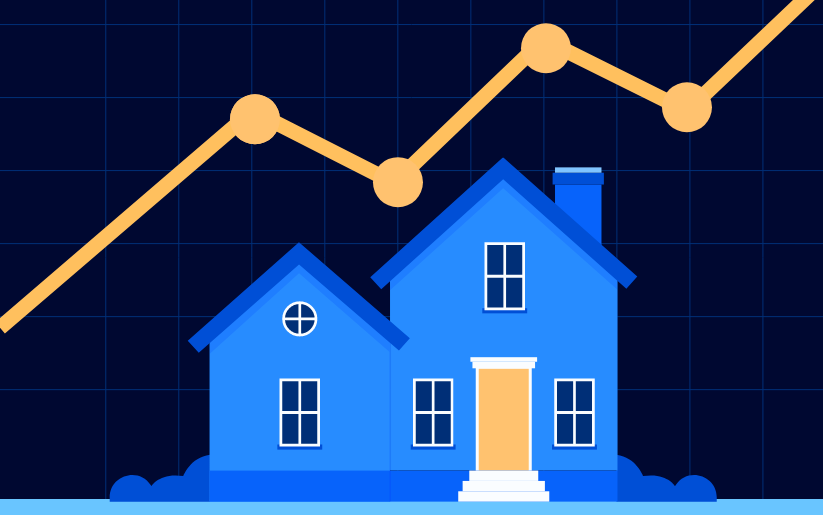Housing Market Tilts in Buyers' Favor as Mortgage Rates Drop Below 7%
Window of Opportunity Opens for Home Buyers as Market Dynamics Shift
The long-awaited reprieve for prospective homebuyers appears to be materializing as February 2025 data reveals a confluence of favorable market conditions. Mortgage rates have descended to 6.78% as of February 26th—their lowest level in over two months—while home price appreciation has decelerated significantly, with the median sale price rising just 3.5% year-over-year during the four weeks ending February 23rd. This marks the smallest annual increase since September 2024.
This shift comes primarily from signals that the U.S. economy is cooling, accompanied by heightened recession concerns. The impact on buyers' purchasing power is substantial, with the recent drop from 7.13% to 6.78% in just two weeks translating to thousands of dollars in savings over the life of a loan.
Housing inventory continues its steady climb, reaching 4.6 months of supply—up from 4 months during the same period last year. This inventory expansion has created a market where the typical home now sells for approximately 2% below asking price, giving buyers unprecedented negotiating leverage not seen in recent years.
Early Signs of Buyer Reengagement Appearing in Market Data
While closed transactions haven't yet reflected these improved conditions, leading indicators suggest buyer interest is rekindling. Redfin's Homebuyer Demand Index, which tracks tours and other homebuying services on a seasonally adjusted basis, has climbed to its highest level since January. Similarly, Google searches for "homes for sale" have reached their peak since September 2024.
The disconnect between rising interest and stagnant sales appears temporary. Pending home sales remain down 6.2% compared to last year, consistent with trends since January. Despite rate improvements, the typical monthly housing payment still hovers near historic highs—just $32 below the all-time record. Industry experts anticipate this gap will close in coming weeks as increased touring activity converts to actual offers, particularly if mortgage rates maintain their downward trajectory.
"The market is at an inflection point," explains market analyst Lindsay Morgan. "Buyers who have been waiting on the sidelines are beginning to test the waters, especially as they see their borrowing costs decrease for the first time in months."
Why Real Estate Professionals Are Advising Buyers to Act Now
Real estate professionals across several markets are encouraging serious buyers to capitalize on this temporary window of opportunity. Their urgency stems from two key concerns: economic volatility that could push rates back above 7%, and the limited growth in new inventory entering the market.
New listings increased just 2.4% year-over-year in the latest reporting period—the smallest gain in a month—suggesting the current supply advantage could quickly evaporate as spring approaches. This creates a unique moment where buyers face less competition while still benefiting from improved financing options.
Alison Williams, a Redfin Premier agent in Sacramento, offers pointed advice: "If you're thinking of purchasing a home in the next six months, don't wait until the flowers start blooming. The market will heat up as we get closer to spring. Now is the time to potentially negotiate down the price of a home, save money on closing costs, or get sellers to cover issues uncovered in the inspection."
Market Segmentation Creates Varying Buyer Experiences
Not all segments of the housing market are behaving identically. Bidding wars remain common for homes priced below $400,000, reflecting persistent demand in the entry-level market where inventory remains especially tight. Similarly, premium properties that are move-in ready in desirable neighborhoods continue to attract multiple offers.
The sweet spot for negotiating power appears to be in the middle market—homes that aren't either budget-friendly starter homes or luxury properties. These mid-tier properties are seeing increased days on market and more room for buyer demands in the negotiation process.
This segmentation is reflected in regional variations as well. Markets like Cleveland (+13.1%), San Jose (+12.6%), and Nassau County (+12%) continue to see substantial price growth, while cities like Austin (-5%), Jacksonville (-2.8%), and Tampa (-2.1%) are experiencing year-over-year price declines.
Outlook: Strategic Opportunities for Different Buyer Profiles
As we approach the traditionally active spring market, various types of buyers face different strategic considerations. First-time buyers may find particular value in the current environment, especially if they target properties that have lingered on the market. Move-up buyers can capitalize on slower price growth in higher price brackets, while investors may find opportunities in markets where prices have actually declined year-over-year.
The months ahead will likely be characterized by regional divergence rather than national trends. San Francisco leads the nation with a 26.9% increase in pending sales, while Houston (-17%), Miami (-16.6%), and Minneapolis (-16.1%) continue to see significant transaction declines. This geographic disparity creates both challenges and opportunities depending on location.
Insights
Are we entering a buyer's market nationwide?
Not entirely. The market is best described as rebalancing rather than fully tilting to buyers. With 4.6 months of supply (where 4-5 months is considered balanced), conditions have improved for buyers but haven't completely shifted the power dynamic. The market remains segmented by price point, with entry-level homes still highly competitive while mid-tier properties offer more negotiating room.
How much has buyer purchasing power increased with the recent rate drop?
The decline from 7.13% to 6.78% translates to approximately $100 less in monthly payments on a $400,000 home with 20% down. Over a 30-year mortgage, this represents tens of thousands in savings. Additionally, more buyers can qualify at the lower rate threshold, expanding the potential buyer pool.
Which markets offer the best opportunity for buyers right now?
Cities experiencing price declines like Austin (-5%), Jacksonville (-2.8%), and Tampa (-2.1%) present immediate value opportunities. Markets with substantial inventory growth, such as Phoenix (with new listings up 23%) and Los Angeles (+22.2%), also provide buyers with more options and negotiating leverage than they've had in years.
Is this a temporary window or the beginning of a longer-term shift?
Most indicators suggest this is a temporary window of opportunity. With new listings growing at just 2.4% year-over-year (the smallest increase in a month) and spring traditionally bringing more buyer activity, the current advantage could diminish in the coming months. Economic uncertainty could also push mortgage rates back up, quickly changing the affordability equation.
When will we see housing market conditions fully normalize?
Full normalization—defined as 4-6 months of consistent inventory, price growth aligned with inflation, and mortgage rates stabilized—likely remains 12-18 months away. The housing market continues to work through the after-effects of pandemic-era disruptions in both supply and demand patterns.













